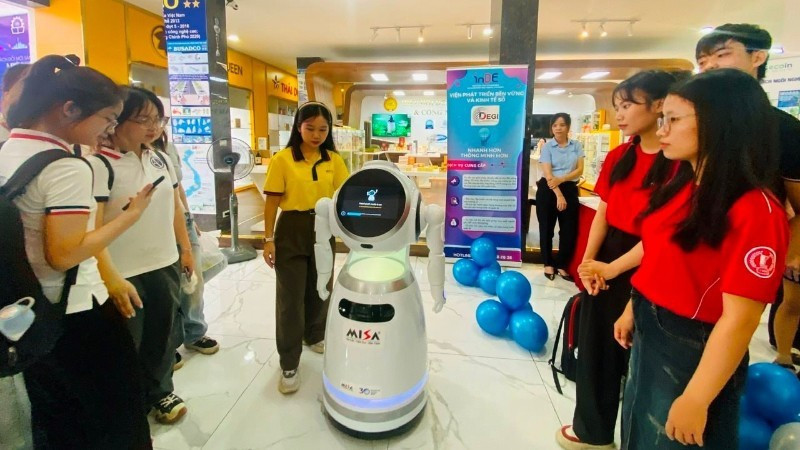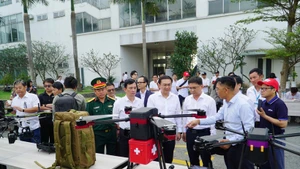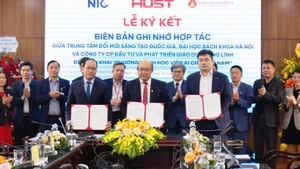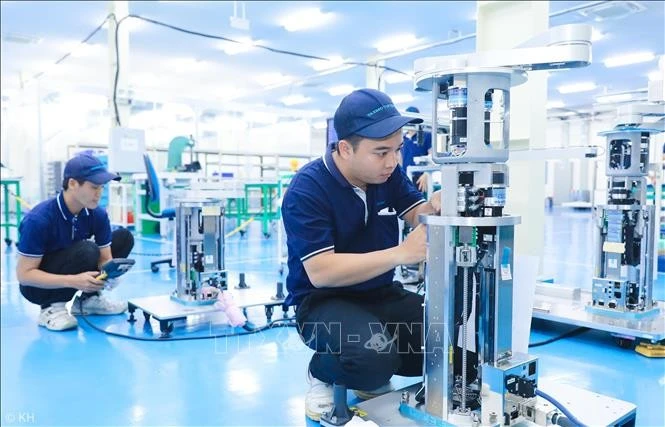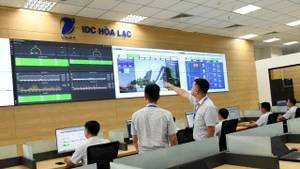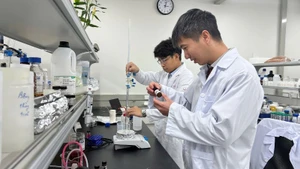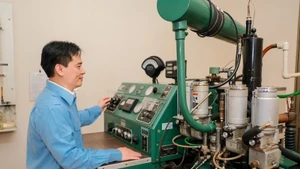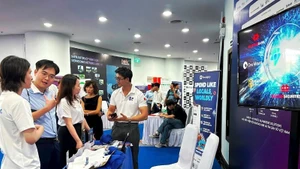Practices from large enterprises to technology startups, from national policies to local models show that only when a truly creative environment is created, can Vietnamese talents maximise their capacity and stay long-term.
Enterprises lead by environment and development opportunities
The Law on Digital Technology Industry will take effect from January 1, 2026, marking a shift in development thinking: From administrative incentives to creating a creative ecosystem, focusing on people. Responding to the spirit of Resolution No.57-NQ/TW dated December 22, 2024 of the Politburo on breakthroughs in science, technology, innovation and national digital transformation (Resolution No.57), large technology corporations such as VNPT and Viettel all have specific strategies to build quality digital human resources.
Chairman and General Director of the military-run telecommunications service provider Viettel Tao Duc Thang said that Viettel has built a “technology school” model with the Digital Talent programme, recruits hundreds of interns each year and proposes to recognise internship time as regular credits...
At the Viet Nam Posts and Telecommunications Group (VNPT), VNPT AI brings interns and young engineers directly to participate in large-scale technology projects, “real-life problems” that require the ability to handle complex situations and deploy on a large scale, helping them accelerate their career growth.
VNPT AI Technology Director Cao Thanh Ha said that over the past 7 years, from 50 initial engineers, the unit now has more than 200 engineers, developing hundreds of AI models serving billions of requests with quality approaching international standards. Recently, VNPT AI has promoted the linkage model among the State, schools, enterprises to connect the strengths of each side, thereby creating sustainable innovation capacity.
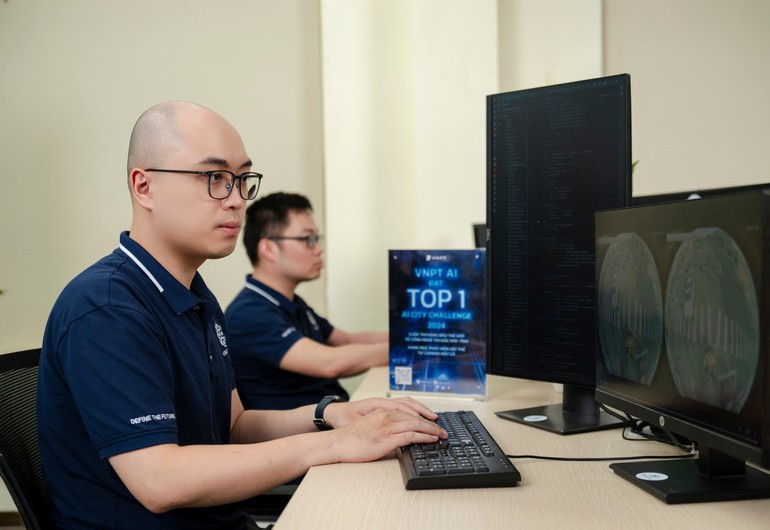
Ha emphasised: “We do not seek a one-way “order-supply” relationship, but aim to co-design training programmes, co-develop products, co-use research results...”.
In addition to developing technology, many businesses have shifted to long-term investment in digital human resource development with creative approaches. MISA Joint Stock Company implements retraining, skill improvement and brings enterprise software into teaching at universities. Many small and medium-sized enterprises also seek to retain talent with their own advantages.
Established with the orientation of providing automation technical solutions, Le Duong Technical Solutions Company Limited has gathered a team of experienced engineers who have participated in FDI projects. However, retaining good employees is always a big challenge. Director Le Dinh Tuyen shared that the decisive factor lies not only in salary and bonuses, but also in the creative environment, cohesive culture and opportunities for the team to develop products with personal imprints.
Opening doors for Vietnamese technology human resources
Some new cooperation models are opening up promising directions for the digital human resources problem. The connection between universities, research institutes and enterprises is expected to create a sustainable innovation chain, from classroom training to research, application and commercialisation of technology products.
In Viet Nam, many major universities have signed training cooperation agreements with technology enterprises to promote training, practice and startup models. The “co-research and co-commercialisation” model not only helps connect institutes, schools and enterprises, but also motivates young people to stay in long-term research. Laboratories have been arranged at research institutes, universities and enterprises for shared use.
According to Deputy Director of the Department of Science, Technology and Technology under the Ministry of Science and Technology Hoang Anh Tu, this is also one of the key tasks to realise the spirit of Resolution No.57 and the Law on Digital Technology Industry through investment in R&D infrastructure associated with multi-stakeholder linkages. The linkage between universities, research institutes and enterprises is gradually forming a pillar in the digital human resource development ecosystem in Viet Nam.
Viet Nam National University, Ho Chi Minh City is implementing the VNU350 Programme with an open mechanism, empowering scientists to choose their own research direction according to their personal strengths. The goal of VNU350 is to attract, retain and develop 350 outstanding young scientists, making the university a top research university in Asia.
A similar initiative is being formed with the proposal to build an “innovation triangle” at Hoa Lac High-Tech Park, where businesses play the role of a creative center, scientists develop knowledge, and the State plays the role of institutional builder, supporting infrastructure and mechanisms and policies.
“This model is being piloted jointly by CMC, Ha Noi University of Science and Technology and the Hoa Lac High-Tech Park Management Board, with the expectation of creating a strong shift in the way the national human resources and innovation ecosystem is operated,” said Nguyen Trung Chinh, Chairman of CMC Technology Group.
Although many linkage models have shown initial effectiveness, Viet Nam has still faced major challenges such as limited technological mastery and under-exploitation of global intellectual resources.
In response to the need for rapid development, experts believe that it is necessary to simultaneously improve the research environment, increase investment in R&D, promote technology transfer and expand international cooperation. In order for these efforts to be most effective, many opinions have proposed piloting a “human resource sandbox”, a flexible mechanism that allows the recruitment and use of experts on a project-by-project basis, helping scientists and high-tech engineers to challenge themselves with practical problems and maximise their capacity.
In fact, VNPT AI has designed specialist positions with salary frameworks, KPIs and flexible working regimes, thereby attracting talent and creating conditions for the team to focus on product development instead of being bound by administrative procedures.
Positive information also comes from the State, that is, the Ministry of Science and Technology has now switched to proactively “ordering” institutes, schools and enterprises instead of waiting for proposals from the grassroots in order to closely follow practical needs and increase policy effectiveness.
Deputy Minister of Science and Technology Bui Hoang Phuong affirmed that this is a shift from a decentralised mindset to a proactive approach, accompanying businesses and scientists in research orientation. To attract talent, it is necessary to go hand in hand with competitive remuneration and a professional research environment. The current focus of institutional reform is to shift from process-based assessment to output measurement.
The Ministry is also building a national database to support policy making. The Law on Digital Technology Industry is an important institutional boost. However, the decision still lies in the actual implementation environment, clear development opportunities and flexible enough talent utilisation mechanisms.
According to experts, only when institutions, businesses and human resources are synchronously connected, can Viet Nam create a sustainable innovation ecosystem.
